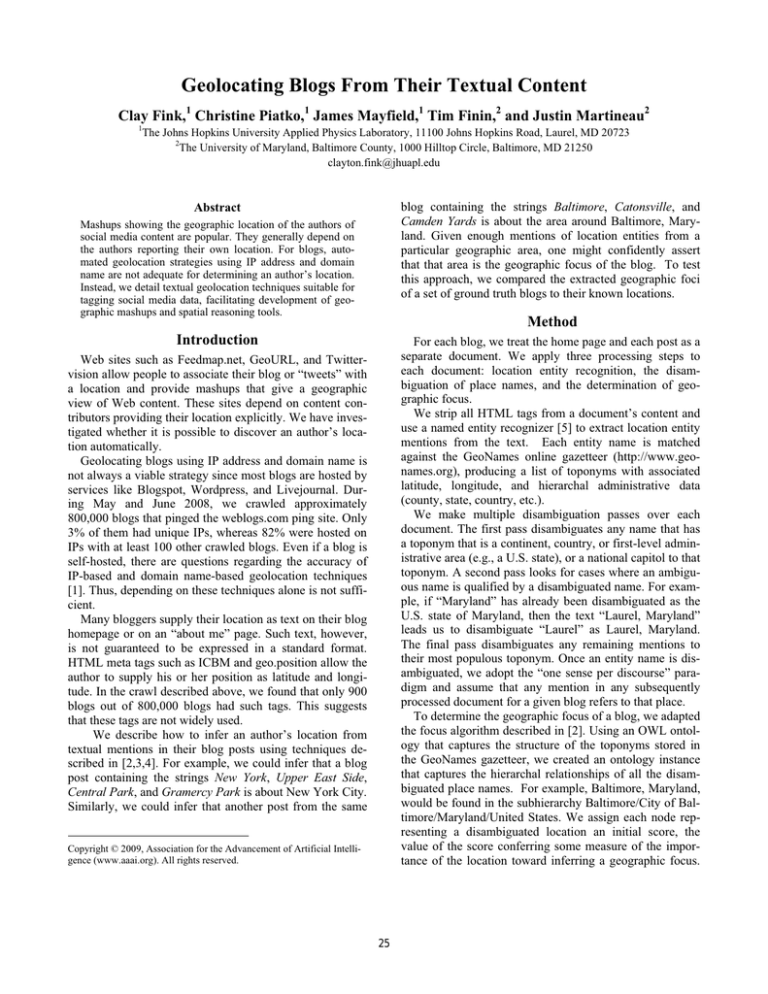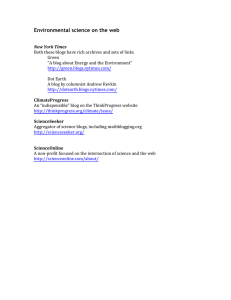
Geolocating Blogs From Their Textual Content
Clay Fink,1 Christine Piatko,1 James Mayfield,1 Tim Finin,2 and Justin Martineau2
1
The Johns Hopkins University Applied Physics Laboratory, 11100 Johns Hopkins Road, Laurel, MD 20723
2
The University of Maryland, Baltimore County, 1000 Hilltop Circle, Baltimore, MD 21250
clayton.fink@jhuapl.edu
blog containing the strings Baltimore, Catonsville, and
Camden Yards is about the area around Baltimore, Maryland. Given enough mentions of location entities from a
particular geographic area, one might confidently assert
that that area is the geographic focus of the blog. To test
this approach, we compared the extracted geographic foci
of a set of ground truth blogs to their known locations.
Abstract
Mashups showing the geographic location of the authors of
social media content are popular. They generally depend on
the authors reporting their own location. For blogs, automated geolocation strategies using IP address and domain
name are not adequate for determining an author’s location.
Instead, we detail textual geolocation techniques suitable for
tagging social media data, facilitating development of geographic mashups and spatial reasoning tools.
Method
Introduction
For each blog, we treat the home page and each post as a
separate document. We apply three processing steps to
each document: location entity recognition, the disambiguation of place names, and the determination of geographic focus.
We strip all HTML tags from a document’s content and
use a named entity recognizer [5] to extract location entity
mentions from the text. Each entity name is matched
against the GeoNames online gazetteer (http://www.geonames.org), producing a list of toponyms with associated
latitude, longitude, and hierarchal administrative data
(county, state, country, etc.).
We make multiple disambiguation passes over each
document. The first pass disambiguates any name that has
a toponym that is a continent, country, or first-level administrative area (e.g., a U.S. state), or a national capitol to that
toponym. A second pass looks for cases where an ambiguous name is qualified by a disambiguated name. For example, if “Maryland” has already been disambiguated as the
U.S. state of Maryland, then the text “Laurel, Maryland”
leads us to disambiguate “Laurel” as Laurel, Maryland.
The final pass disambiguates any remaining mentions to
their most populous toponym. Once an entity name is disambiguated, we adopt the “one sense per discourse” paradigm and assume that any mention in any subsequently
processed document for a given blog refers to that place.
To determine the geographic focus of a blog, we adapted
the focus algorithm described in [2]. Using an OWL ontology that captures the structure of the toponyms stored in
the GeoNames gazetteer, we created an ontology instance
that captures the hierarchal relationships of all the disambiguated place names. For example, Baltimore, Maryland,
would be found in the subhierarchy Baltimore/City of Baltimore/Maryland/United States. We assign each node representing a disambiguated location an initial score, the
value of the score conferring some measure of the importance of the location toward inferring a geographic focus.
Web sites such as Feedmap.net, GeoURL, and Twittervision allow people to associate their blog or “tweets” with
a location and provide mashups that give a geographic
view of Web content. These sites depend on content contributors providing their location explicitly. We have investigated whether it is possible to discover an author’s location automatically.
Geolocating blogs using IP address and domain name is
not always a viable strategy since most blogs are hosted by
services like Blogspot, Wordpress, and Livejournal. During May and June 2008, we crawled approximately
800,000 blogs that pinged the weblogs.com ping site. Only
3% of them had unique IPs, whereas 82% were hosted on
IPs with at least 100 other crawled blogs. Even if a blog is
self-hosted, there are questions regarding the accuracy of
IP-based and domain name-based geolocation techniques
[1]. Thus, depending on these techniques alone is not sufficient.
Many bloggers supply their location as text on their blog
homepage or on an “about me” page. Such text, however,
is not guaranteed to be expressed in a standard format.
HTML meta tags such as ICBM and geo.position allow the
author to supply his or her position as latitude and longitude. In the crawl described above, we found that only 900
blogs out of 800,000 blogs had such tags. This suggests
that these tags are not widely used.
We describe how to infer an author’s location from
textual mentions in their blog posts using techniques described in [2,3,4]. For example, we could infer that a blog
post containing the strings New York, Upper East Side,
Central Park, and Gramercy Park is about New York City.
Similarly, we could infer that another post from the same
Copyright © 2009, Association for the Advancement of Artificial Intelligence (www.aaai.org). All rights reserved.
25
For example, initial scoring could be based on the confidence associated with the disambiguation. The remaining
nodes in the hierarchy are given an initial score of zero.
We then apply a scoring algorithm, following the work in
[2], that propagates the scores up the hierarchy, starting at
the leaf nodes, with the score decaying as the location becomes more general. Let n be a node at level L 1 of the
hierarchy, with L = 0 at the leaf nodes. Let In = initial score
of node n. Let si be the accumulated score, or initial score
if it is a leaf node, of child i of node n. Finally, let D be a
decay constant where 0 < D < 1. The accumulated score,
sn, of node n is
Conclusion
Our results suggest that for many blogs, the extracted
geographic focus does indeed correspond to the author’s
location. Our future work will include improving the accuracy of this algorithm. A named entity recognizer trained
on blog text might improve performance since the one used
was trained on text from news stories. Better disambiguation strategies might also improve performance. Both improvements would provide a larger number of disambiguated place names for determining geographic focus. A hybrid approach that combines the use of IP and domain
name geolocation, and any useful metadata, with our technique might also improve performance. Handling cases
where multiple geographic foci are reported might boost
our accuracy as well.
We will also investigate two hypotheses. The first is that
we can learn to distinguish blogs for which the technique is
effective from those where it is not. This will likely depend, for example, on blog attributes such as blog genre
(e.g., diary vs. professional), topic, or number of authors.
The second is that we can learn to classify toponym mentions that are likely to refer to locations near the author
from those that are not, based on features in the surrounding text. For example, toponyms in sentences containing I
and we may be more likely to provide evidence of the author’s location at different points in time.
sn = In + s2i DL-1
After applying this algorithm to the entire hierarchy graph,
the higher scoring nodes - ignoring nodes for the globe and
continents - will represent regions containing more disambiguated place names than those represented by lower scoring nodes.
Experiment
We collected approximately 1,000 English language
blogs by authors who self-reported their location as the
United States. The blogs were identified by crawling the
weblogs.com ping server and searching for blogs with the
HTML meta tags ICBM or geo.position. Additional blogs
were taken from feedmap.net, where authors can register
their locations. We retrieved posts for each blog using the
Google Reader API going back as far as data was available. All blogs used were updated regularly (more than
twice a month) and recently (since June 1, 2008), and we
also screened out spam blogs [6]. The blogs were then
checked manually to determine if the blogger’s reported
location was accurate. The location was modified if it did
not match the author’s actual location, which was determined by reading the content of some of their posts. Blogs
for which we could not verify the location were not used.
We tested our algorithm against 500 blogs from our collection, using posts authored between January 1, 2005, and
November 1, 2008. The scores for disambiguated place
names in the hierarchy were initialized with an initial value
of 0.5, and we used a decay constant of 0.8. For blogs
where there was insufficient clustering of the nodes to
cause the propagation of scores up the hierarchy, we ignored the result. To select the geographic focus of a blog,
we traversed down the hierarchy, starting at the highest
scoring node, and selected the subnode that was lowest in
the hierarchy and had the highest accumulated score. A
correct result was defined as being when the extracted
geographic focus subsumed the blog’s true location, or was
within 100 miles of it. We had 295 matches out of 481
usable results for 61% accuracy. For the 295 matches, the
average distance from the extracted location to the known
location was 50.8 miles .
References
[1] Muir, J., van Oorschot, P. (2006). Internet geolocation
and evasion (TR-06-05). School of Computer Science,
Carleton University.
[2] Amitay, E., Har'El, N., Sivan, R., & Soffer, A. (2004).
Web-a-where: Geotagging Web content. Proc. of the
27th Annual Int. ACM SIGIR Conf. on Research and
Development in Information Retrieval, 273-280.
[3] Smith, D., & Crane, G. (2001). Disambiguating geographic names in a historical digital library. Proc. of
the 5th European Conf. on Research and Advanced
Technology for Digital Libraries, 127-136.
[4] Zong, W., Wu, D., Sun, A., Lim, E. P., & Goh, D. H.
(2005). On assigning place names to geography related Web pages. Proc. of the 5th ACM+IEEE Joint
Conf. on Digital Libraries, 354-362.
[5] Finkel, J, Grenager, T., & Manning, C. (2005). Incorporating non-local information into information extraction systems by Gibbs sampling. Proc. of the 43rd
Annual Meeting of the Association for Computational
Linguistics, 363-370.
[6] Kolari P., Java A., Finin, T., Oates T., & Joshi, A.
(2006), Detecting spam blogs: A machine learning
approach. Proc. of the 21st National Conf. on
Artificial Intelligence.
26




